DODGE NEON 1999 Service Repair Manual
Manufacturer: DODGE, Model Year: 1999, Model line: NEON, Model: DODGE NEON 1999Pages: 1200, PDF Size: 35.29 MB
Page 901 of 1200

Page 902 of 1200
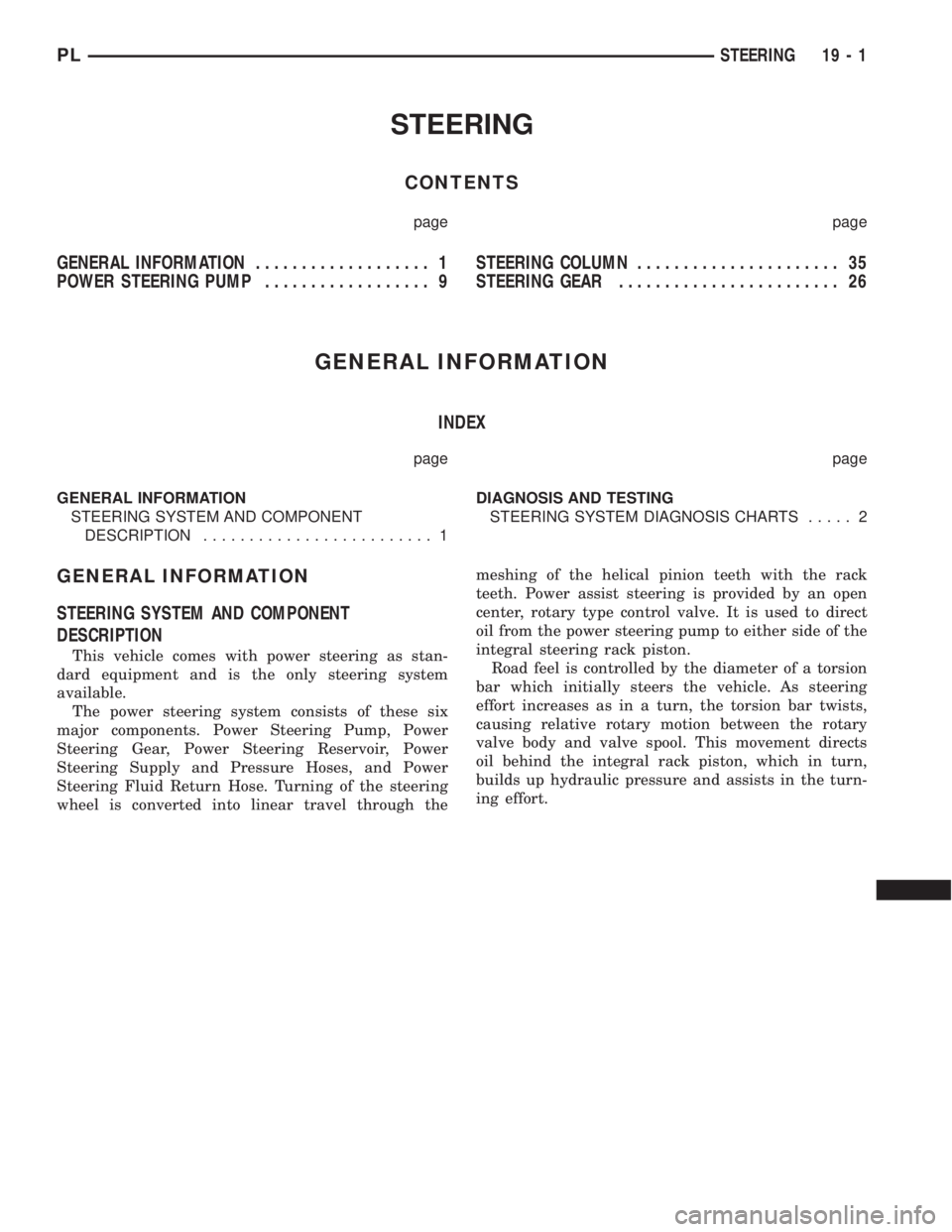
STEERING
CONTENTS
page page
GENERAL INFORMATION................... 1
POWER STEERING PUMP.................. 9STEERING COLUMN...................... 35
STEERING GEAR........................ 26
GENERAL INFORMATION
INDEX
page page
GENERAL INFORMATION
STEERING SYSTEM AND COMPONENT
DESCRIPTION......................... 1DIAGNOSIS AND TESTING
STEERING SYSTEM DIAGNOSIS CHARTS..... 2
GENERAL INFORMATION
STEERING SYSTEM AND COMPONENT
DESCRIPTION
This vehicle comes with power steering as stan-
dard equipment and is the only steering system
available.
The power steering system consists of these six
major components. Power Steering Pump, Power
Steering Gear, Power Steering Reservoir, Power
Steering Supply and Pressure Hoses, and Power
Steering Fluid Return Hose. Turning of the steering
wheel is converted into linear travel through themeshing of the helical pinion teeth with the rack
teeth. Power assist steering is provided by an open
center, rotary type control valve. It is used to direct
oil from the power steering pump to either side of the
integral steering rack piston.
Road feel is controlled by the diameter of a torsion
bar which initially steers the vehicle. As steering
effort increases as in a turn, the torsion bar twists,
causing relative rotary motion between the rotary
valve body and valve spool. This movement directs
oil behind the integral rack piston, which in turn,
builds up hydraulic pressure and assists in the turn-
ing effort.
PLSTEERING 19 - 1
Page 903 of 1200
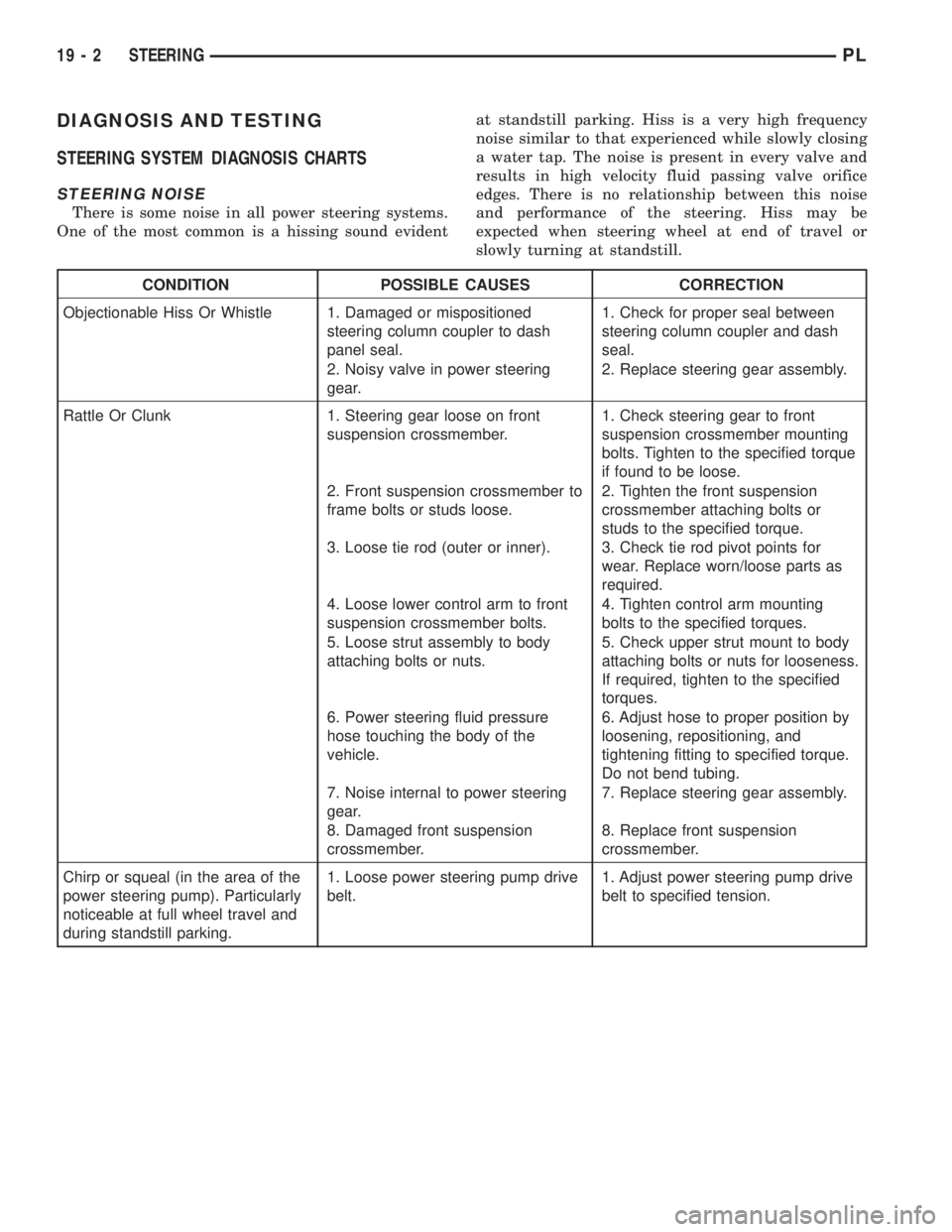
DIAGNOSIS AND TESTING
STEERING SYSTEM DIAGNOSIS CHARTS
STEERING NOISE
There is some noise in all power steering systems.
One of the most common is a hissing sound evidentat standstill parking. Hiss is a very high frequency
noise similar to that experienced while slowly closing
a water tap. The noise is present in every valve and
results in high velocity fluid passing valve orifice
edges. There is no relationship between this noise
and performance of the steering. Hiss may be
expected when steering wheel at end of travel or
slowly turning at standstill.
CONDITION POSSIBLE CAUSES CORRECTION
Objectionable Hiss Or Whistle 1. Damaged or mispositioned
steering column coupler to dash
panel seal.1. Check for proper seal between
steering column coupler and dash
seal.
2. Noisy valve in power steering
gear.2. Replace steering gear assembly.
Rattle Or Clunk 1. Steering gear loose on front
suspension crossmember.1. Check steering gear to front
suspension crossmember mounting
bolts. Tighten to the specified torque
if found to be loose.
2. Front suspension crossmember to
frame bolts or studs loose.2. Tighten the front suspension
crossmember attaching bolts or
studs to the specified torque.
3. Loose tie rod (outer or inner). 3. Check tie rod pivot points for
wear. Replace worn/loose parts as
required.
4. Loose lower control arm to front
suspension crossmember bolts.4. Tighten control arm mounting
bolts to the specified torques.
5. Loose strut assembly to body
attaching bolts or nuts.5. Check upper strut mount to body
attaching bolts or nuts for looseness.
If required, tighten to the specified
torques.
6. Power steering fluid pressure
hose touching the body of the
vehicle.6. Adjust hose to proper position by
loosening, repositioning, and
tightening fitting to specified torque.
Do not bend tubing.
7. Noise internal to power steering
gear.7. Replace steering gear assembly.
8. Damaged front suspension
crossmember.8. Replace front suspension
crossmember.
Chirp or squeal (in the area of the
power steering pump). Particularly
noticeable at full wheel travel and
during standstill parking.1. Loose power steering pump drive
belt.1. Adjust power steering pump drive
belt to specified tension.
19 - 2 STEERINGPL
Page 904 of 1200
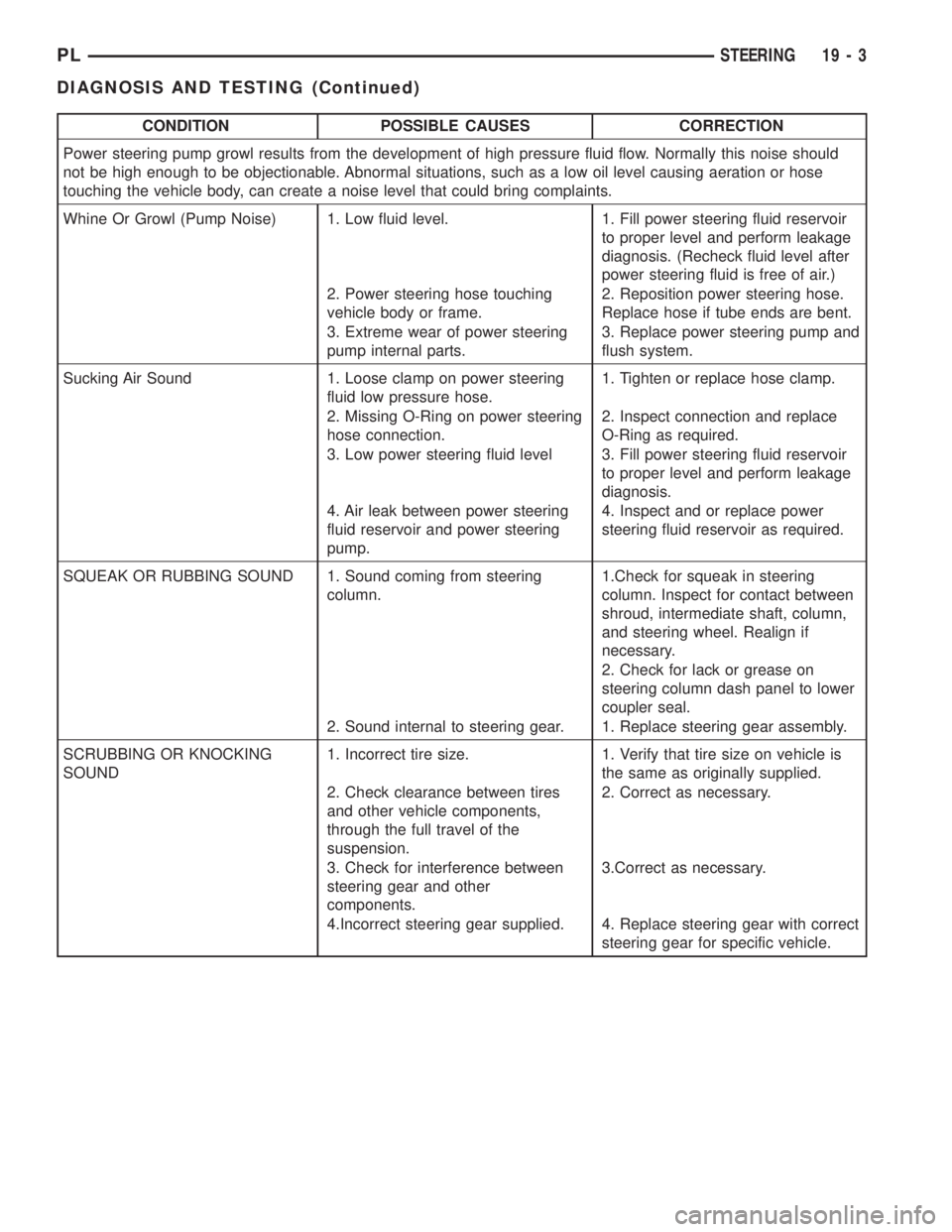
CONDITION POSSIBLE CAUSES CORRECTION
Power steering pump growl results from the development of high pressure fluid flow. Normally this noise should
not be high enough to be objectionable. Abnormal situations, such as a low oil level causing aeration or hose
touching the vehicle body, can create a noise level that could bring complaints.
Whine Or Growl (Pump Noise) 1. Low fluid level. 1. Fill power steering fluid reservoir
to proper level and perform leakage
diagnosis. (Recheck fluid level after
power steering fluid is free of air.)
2. Power steering hose touching
vehicle body or frame.2. Reposition power steering hose.
Replace hose if tube ends are bent.
3. Extreme wear of power steering
pump internal parts.3. Replace power steering pump and
flush system.
Sucking Air Sound 1. Loose clamp on power steering
fluid low pressure hose.1. Tighten or replace hose clamp.
2. Missing O-Ring on power steering
hose connection.2. Inspect connection and replace
O-Ring as required.
3. Low power steering fluid level 3. Fill power steering fluid reservoir
to proper level and perform leakage
diagnosis.
4. Air leak between power steering
fluid reservoir and power steering
pump.4. Inspect and or replace power
steering fluid reservoir as required.
SQUEAK OR RUBBING SOUND 1. Sound coming from steering
column.1.Check for squeak in steering
column. Inspect for contact between
shroud, intermediate shaft, column,
and steering wheel. Realign if
necessary.
2. Check for lack or grease on
steering column dash panel to lower
coupler seal.
2. Sound internal to steering gear. 1. Replace steering gear assembly.
SCRUBBING OR KNOCKING
SOUND1. Incorrect tire size. 1. Verify that tire size on vehicle is
the same as originally supplied.
2. Check clearance between tires
and other vehicle components,
through the full travel of the
suspension.2. Correct as necessary.
3. Check for interference between
steering gear and other
components.3.Correct as necessary.
4.Incorrect steering gear supplied. 4. Replace steering gear with correct
steering gear for specific vehicle.
PLSTEERING 19 - 3
DIAGNOSIS AND TESTING (Continued)
Page 905 of 1200
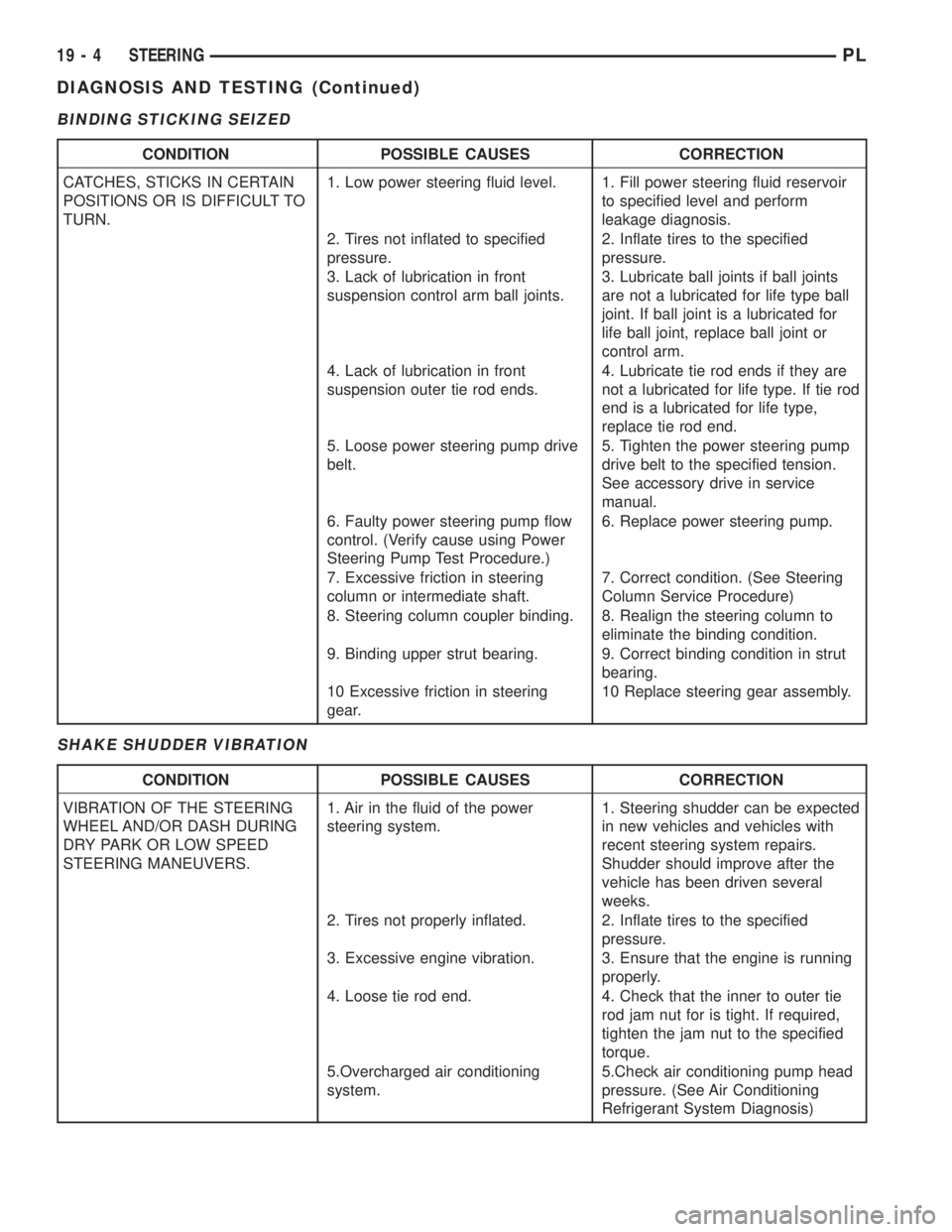
BINDING STICKING SEIZED
SHAKE SHUDDER VIBRATION
CONDITION POSSIBLE CAUSES CORRECTION
CATCHES, STICKS IN CERTAIN
POSITIONS OR IS DIFFICULT TO
TURN.1. Low power steering fluid level. 1. Fill power steering fluid reservoir
to specified level and perform
leakage diagnosis.
2. Tires not inflated to specified
pressure.2. Inflate tires to the specified
pressure.
3. Lack of lubrication in front
suspension control arm ball joints.3. Lubricate ball joints if ball joints
are not a lubricated for life type ball
joint. If ball joint is a lubricated for
life ball joint, replace ball joint or
control arm.
4. Lack of lubrication in front
suspension outer tie rod ends.4. Lubricate tie rod ends if they are
not a lubricated for life type. If tie rod
end is a lubricated for life type,
replace tie rod end.
5. Loose power steering pump drive
belt.5. Tighten the power steering pump
drive belt to the specified tension.
See accessory drive in service
manual.
6. Faulty power steering pump flow
control. (Verify cause using Power
Steering Pump Test Procedure.)6. Replace power steering pump.
7. Excessive friction in steering
column or intermediate shaft.7. Correct condition. (See Steering
Column Service Procedure)
8. Steering column coupler binding. 8. Realign the steering column to
eliminate the binding condition.
9. Binding upper strut bearing. 9. Correct binding condition in strut
bearing.
10 Excessive friction in steering
gear.10 Replace steering gear assembly.
CONDITION POSSIBLE CAUSES CORRECTION
VIBRATION OF THE STEERING
WHEEL AND/OR DASH DURING
DRY PARK OR LOW SPEED
STEERING MANEUVERS.1. Air in the fluid of the power
steering system.1. Steering shudder can be expected
in new vehicles and vehicles with
recent steering system repairs.
Shudder should improve after the
vehicle has been driven several
weeks.
2. Tires not properly inflated. 2. Inflate tires to the specified
pressure.
3. Excessive engine vibration. 3. Ensure that the engine is running
properly.
4. Loose tie rod end. 4. Check that the inner to outer tie
rod jam nut for is tight. If required,
tighten the jam nut to the specified
torque.
5.Overcharged air conditioning
system.5.Check air conditioning pump head
pressure. (See Air Conditioning
Refrigerant System Diagnosis)
19 - 4 STEERINGPL
DIAGNOSIS AND TESTING (Continued)
Page 906 of 1200
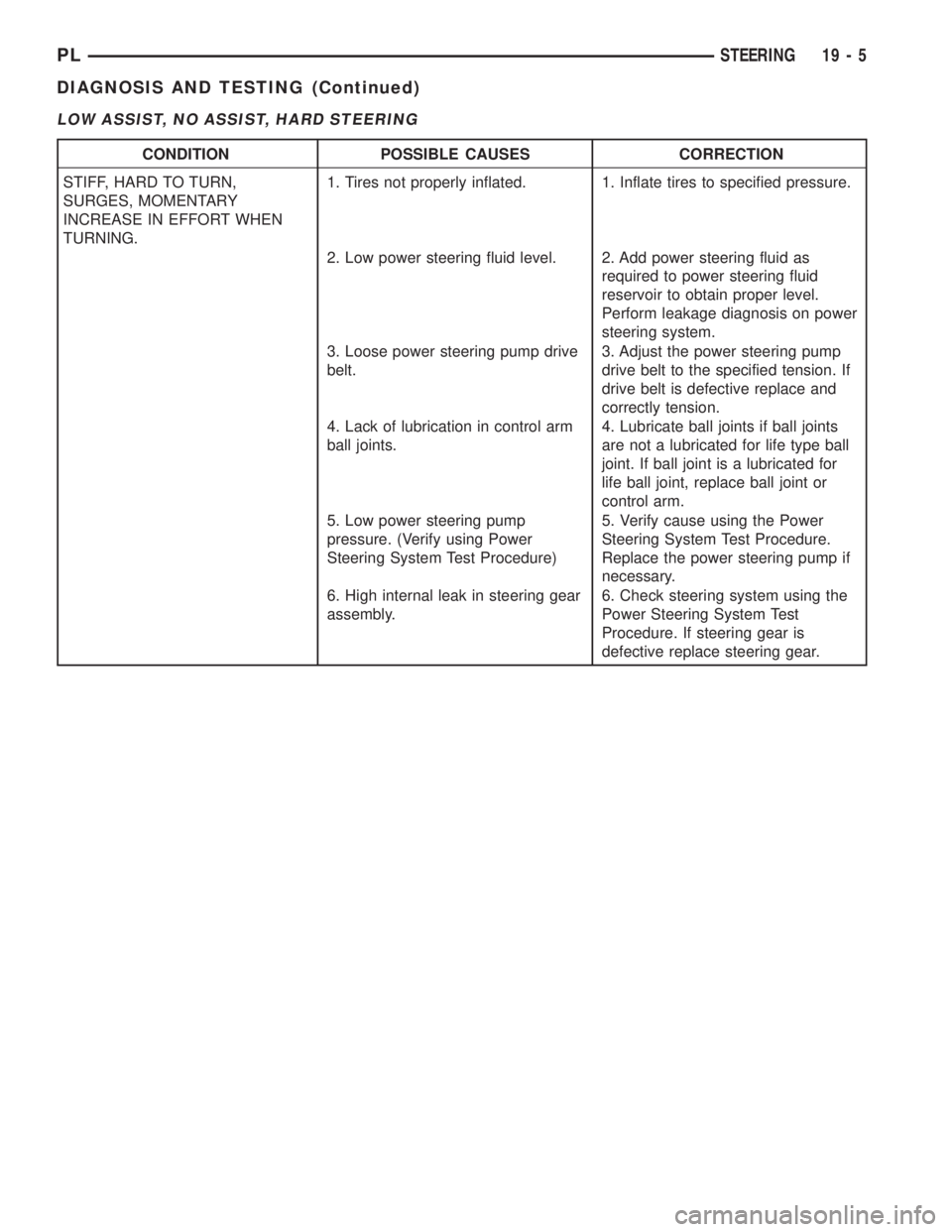
LOW ASSIST, NO ASSIST, HARD STEERING
CONDITION POSSIBLE CAUSES CORRECTION
STIFF, HARD TO TURN,
SURGES, MOMENTARY
INCREASE IN EFFORT WHEN
TURNING.1. Tires not properly inflated. 1. Inflate tires to specified pressure.
2. Low power steering fluid level. 2. Add power steering fluid as
required to power steering fluid
reservoir to obtain proper level.
Perform leakage diagnosis on power
steering system.
3. Loose power steering pump drive
belt.3. Adjust the power steering pump
drive belt to the specified tension. If
drive belt is defective replace and
correctly tension.
4. Lack of lubrication in control arm
ball joints.4. Lubricate ball joints if ball joints
are not a lubricated for life type ball
joint. If ball joint is a lubricated for
life ball joint, replace ball joint or
control arm.
5. Low power steering pump
pressure. (Verify using Power
Steering System Test Procedure)5. Verify cause using the Power
Steering System Test Procedure.
Replace the power steering pump if
necessary.
6. High internal leak in steering gear
assembly.6. Check steering system using the
Power Steering System Test
Procedure. If steering gear is
defective replace steering gear.
PLSTEERING 19 - 5
DIAGNOSIS AND TESTING (Continued)
Page 907 of 1200
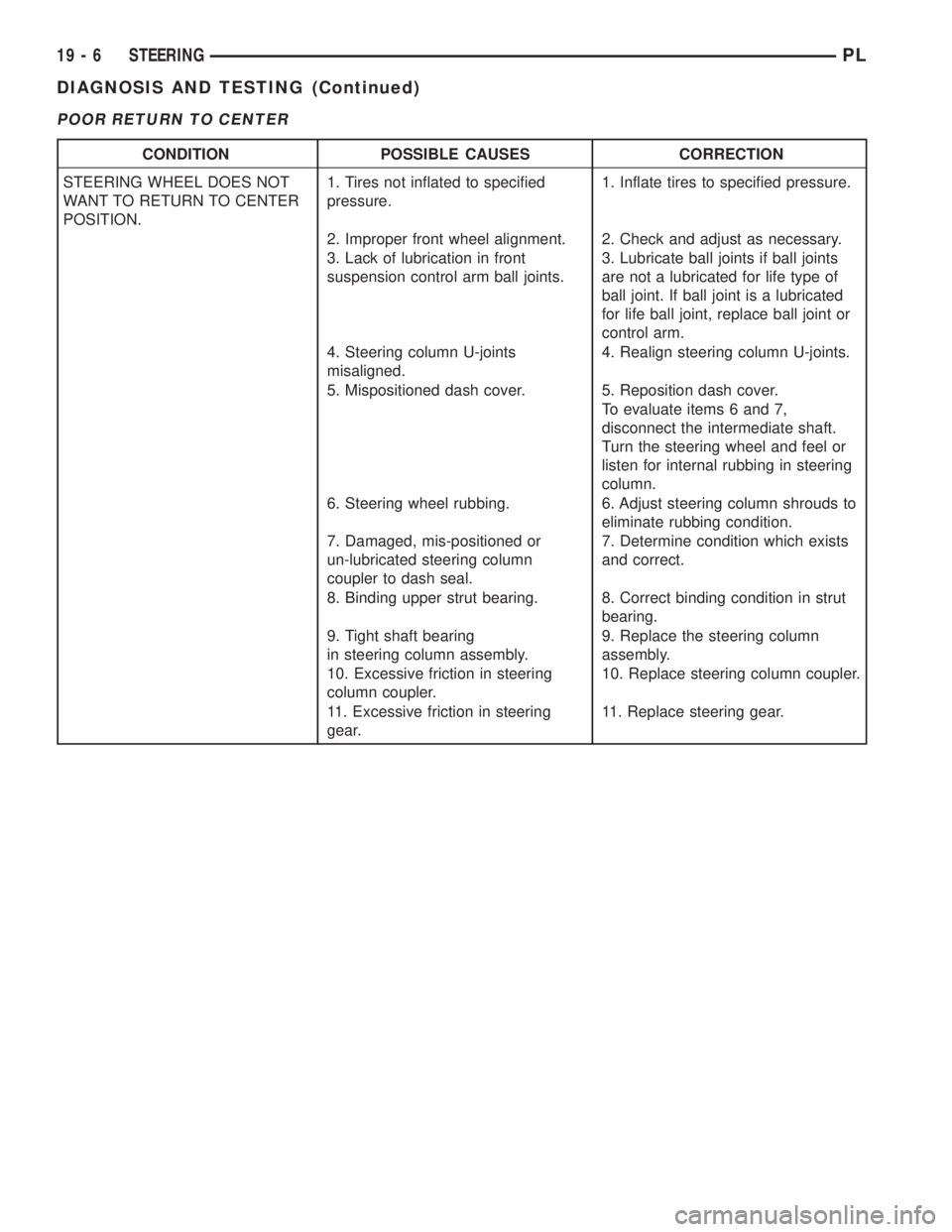
POOR RETURN TO CENTER
CONDITION POSSIBLE CAUSES CORRECTION
STEERING WHEEL DOES NOT
WANT TO RETURN TO CENTER
POSITION.1. Tires not inflated to specified
pressure.1. Inflate tires to specified pressure.
2. Improper front wheel alignment. 2. Check and adjust as necessary.
3. Lack of lubrication in front
suspension control arm ball joints.3. Lubricate ball joints if ball joints
are not a lubricated for life type of
ball joint. If ball joint is a lubricated
for life ball joint, replace ball joint or
control arm.
4. Steering column U-joints
misaligned.4. Realign steering column U-joints.
5. Mispositioned dash cover. 5. Reposition dash cover.
To evaluate items 6 and 7,
disconnect the intermediate shaft.
Turn the steering wheel and feel or
listen for internal rubbing in steering
column.
6. Steering wheel rubbing. 6. Adjust steering column shrouds to
eliminate rubbing condition.
7. Damaged, mis-positioned or
un-lubricated steering column
coupler to dash seal.7. Determine condition which exists
and correct.
8. Binding upper strut bearing. 8. Correct binding condition in strut
bearing.
9. Tight shaft bearing
in steering column assembly.9. Replace the steering column
assembly.
10. Excessive friction in steering
column coupler.10. Replace steering column coupler.
11. Excessive friction in steering
gear.11. Replace steering gear.
19 - 6 STEERINGPL
DIAGNOSIS AND TESTING (Continued)
Page 908 of 1200
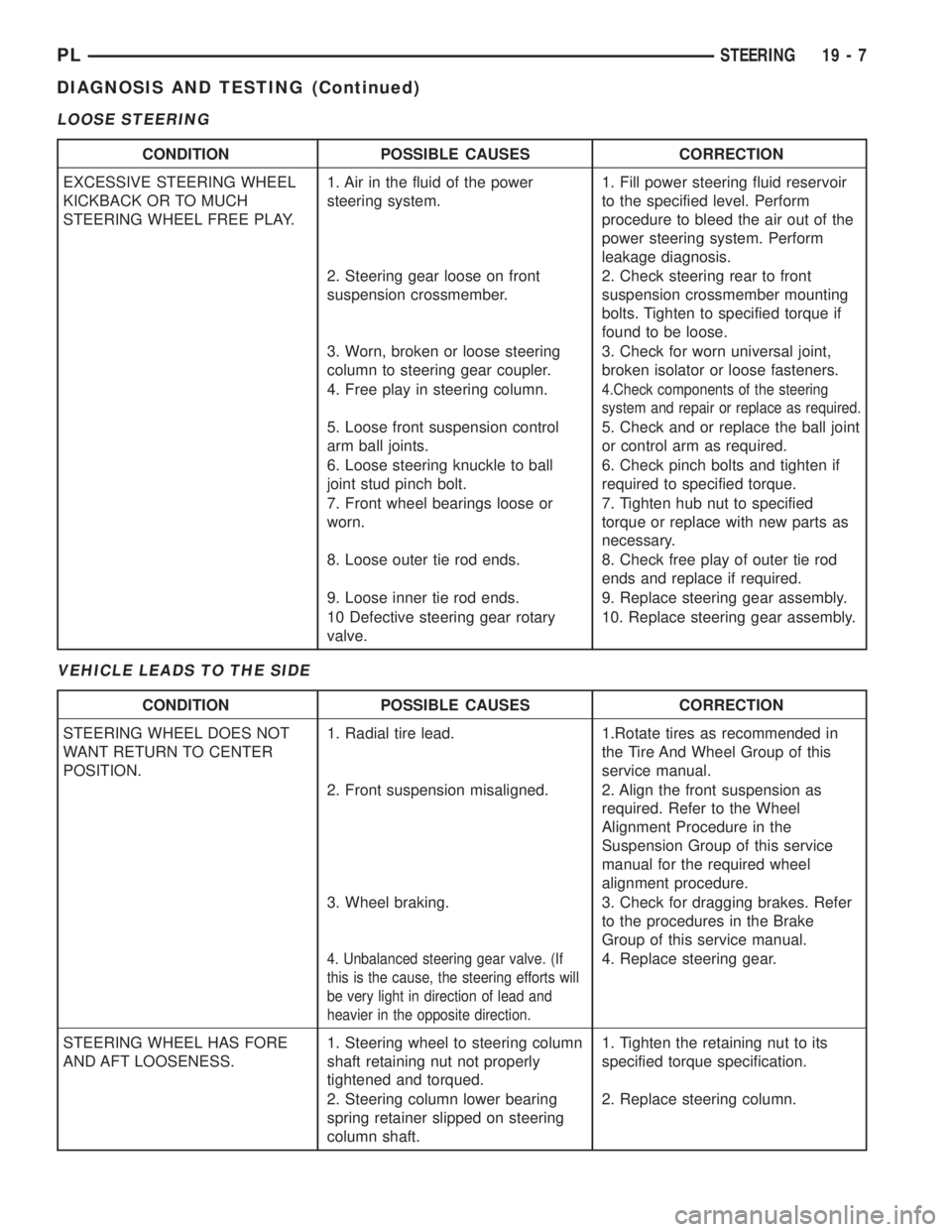
LOOSE STEERING
VEHICLE LEADS TO THE SIDE
CONDITION POSSIBLE CAUSES CORRECTION
EXCESSIVE STEERING WHEEL
KICKBACK OR TO MUCH
STEERING WHEEL FREE PLAY.1. Air in the fluid of the power
steering system.1. Fill power steering fluid reservoir
to the specified level. Perform
procedure to bleed the air out of the
power steering system. Perform
leakage diagnosis.
2. Steering gear loose on front
suspension crossmember.2. Check steering rear to front
suspension crossmember mounting
bolts. Tighten to specified torque if
found to be loose.
3. Worn, broken or loose steering
column to steering gear coupler.3. Check for worn universal joint,
broken isolator or loose fasteners.
4. Free play in steering column.
4.Check components of the steering
system and repair or replace as required.
5. Loose front suspension control
arm ball joints.5. Check and or replace the ball joint
or control arm as required.
6. Loose steering knuckle to ball
joint stud pinch bolt.6. Check pinch bolts and tighten if
required to specified torque.
7. Front wheel bearings loose or
worn.7. Tighten hub nut to specified
torque or replace with new parts as
necessary.
8. Loose outer tie rod ends. 8. Check free play of outer tie rod
ends and replace if required.
9. Loose inner tie rod ends. 9. Replace steering gear assembly.
10 Defective steering gear rotary
valve.10. Replace steering gear assembly.
CONDITION POSSIBLE CAUSES CORRECTION
STEERING WHEEL DOES NOT
WANT RETURN TO CENTER
POSITION.1. Radial tire lead. 1.Rotate tires as recommended in
the Tire And Wheel Group of this
service manual.
2. Front suspension misaligned. 2. Align the front suspension as
required. Refer to the Wheel
Alignment Procedure in the
Suspension Group of this service
manual for the required wheel
alignment procedure.
3. Wheel braking. 3. Check for dragging brakes. Refer
to the procedures in the Brake
Group of this service manual.
4. Unbalanced steering gear valve. (If
this is the cause, the steering efforts will
be very light in direction of lead and
heavier in the opposite direction.4. Replace steering gear.
STEERING WHEEL HAS FORE
AND AFT LOOSENESS.1. Steering wheel to steering column
shaft retaining nut not properly
tightened and torqued.1. Tighten the retaining nut to its
specified torque specification.
2. Steering column lower bearing
spring retainer slipped on steering
column shaft.2. Replace steering column.
PLSTEERING 19 - 7
DIAGNOSIS AND TESTING (Continued)
Page 909 of 1200
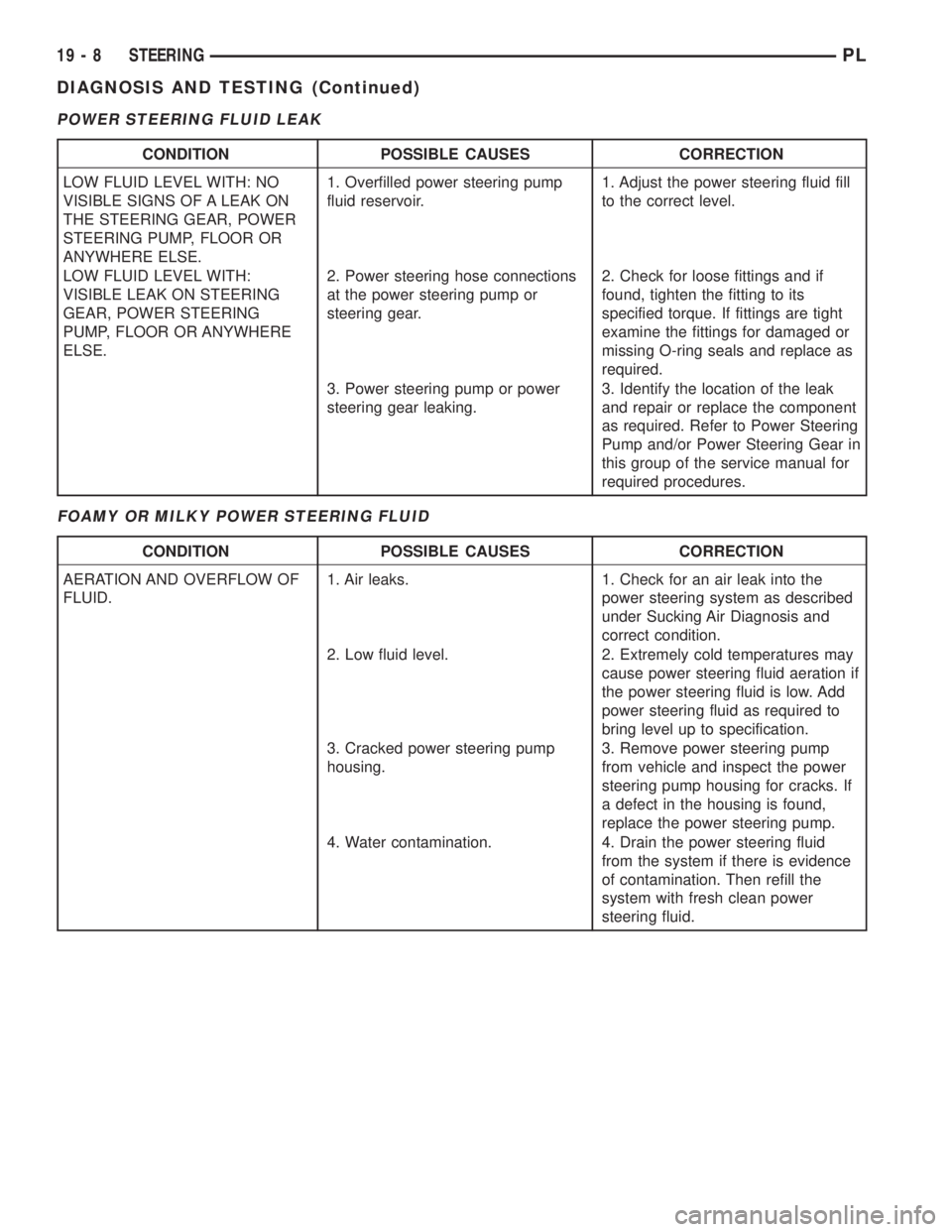
POWER STEERING FLUID LEAK
FOAMY OR MILKY POWER STEERING FLUID
CONDITION POSSIBLE CAUSES CORRECTION
LOW FLUID LEVEL WITH: NO
VISIBLE SIGNS OF A LEAK ON
THE STEERING GEAR, POWER
STEERING PUMP, FLOOR OR
ANYWHERE ELSE.1. Overfilled power steering pump
fluid reservoir.1. Adjust the power steering fluid fill
to the correct level.
LOW FLUID LEVEL WITH:
VISIBLE LEAK ON STEERING
GEAR, POWER STEERING
PUMP, FLOOR OR ANYWHERE
ELSE.2. Power steering hose connections
at the power steering pump or
steering gear.2. Check for loose fittings and if
found, tighten the fitting to its
specified torque. If fittings are tight
examine the fittings for damaged or
missing O-ring seals and replace as
required.
3. Power steering pump or power
steering gear leaking.3. Identify the location of the leak
and repair or replace the component
as required. Refer to Power Steering
Pump and/or Power Steering Gear in
this group of the service manual for
required procedures.
CONDITION POSSIBLE CAUSES CORRECTION
AERATION AND OVERFLOW OF
FLUID.1. Air leaks. 1. Check for an air leak into the
power steering system as described
under Sucking Air Diagnosis and
correct condition.
2. Low fluid level. 2. Extremely cold temperatures may
cause power steering fluid aeration if
the power steering fluid is low. Add
power steering fluid as required to
bring level up to specification.
3. Cracked power steering pump
housing.3. Remove power steering pump
from vehicle and inspect the power
steering pump housing for cracks. If
a defect in the housing is found,
replace the power steering pump.
4. Water contamination. 4. Drain the power steering fluid
from the system if there is evidence
of contamination. Then refill the
system with fresh clean power
steering fluid.
19 - 8 STEERINGPL
DIAGNOSIS AND TESTING (Continued)
Page 910 of 1200

POWER STEERING PUMP
INDEX
page page
DESCRIPTION AND OPERATION
POWER STEERING PUMP................. 9
DIAGNOSIS AND TESTING
POWER STEERING SYSTEM TEST
PROCEDURE......................... 10
SERVICE PROCEDURES
POWER STEERING PUMP
FLOW CONTROL VALVE SEAL............ 11
POWER STEERING PUMP
INITIAL OPERATION.................... 11
POWER STEERING PUMP
SUCTION PORT SEAL.................. 12
POWER STEERING SYSTEM
FLUID LEVEL CHECK................... 11
REMOVAL AND INSTALLATION
POWER STEERING FLUID PRESSURE HOSE . . 13
POWER STEERING FLUID RESERVOIR...... 21POWER STEERING FLUID RETURN HOSE.... 15
POWER STEERING FLUID SUPPLY HOSE
RESERVOIR TO POWER STEERING PUMP . . 17
POWER STEERING PRESSURE SWITCH..... 12
POWER STEERING PUMP (ALL ENGINES).... 18
DISASSEMBLY AND ASSEMBLY
POWER STEERING PUMP DRIVE PULLEY.... 22
POWER STEERING PUMP MOUNTING
BRACKET............................ 23
SPECIFICATIONS
POWER STEERING PUMP FASTENER
TORQUE SPECIFICATIONS.............. 25
POWER STEERING PUMP FLOW
SPECIFICATIONS...................... 25
SPECIAL TOOLS
POWER STEERING PUMP................. 25
DESCRIPTION AND OPERATION
POWER STEERING PUMP
On all vehicles equipped with power steering, the
hydraulic pressure for operation of the power steer-
ing gear is provided by a belt driven power steering
pump (Fig. 1). The TTA power steering pump is a
constant flow rate and displacement, vane type pump
.
In the event of a power steering pump drive belt
failure, manual steering control of the vehicle can
still be maintained. However, under these conditions,
steering effort will be significantly increased.All vehicles equipped with power steering use a
remote mounted reservoir for the power steering
fluid. The power steering fluid remote reservoir is
mounted to the rear of the cylinder head on the pas-
senger side of the vehicle.
The service procedures for the TTA power steering
pump are limited to the areas and components listed
below.No repair procedures are to be done on
internal components of the TTA power steering
pumps.
²Repair of power steering fluid leaks from areas
of the power steering pump sealed by O-rings is
allowed (See Pump Leak Diagnosis). However power
steering pump shaft seal leakage will require
replacement of the pump.
²Power steering fluid reservoirs, related compo-
nents and attaching hardware.
²Power steering fluid reservoir filler cap/dipstick
assemblies.
Because of unique shaft bearings, flow control lev-
els or pump displacements, power steering pumps
may be used only on specific vehicle applications. Be
sure that all power steering pumps are only replaced
with a pump that is the correct replacement for that
specific application.
Hydraulic pressure is provided for operation of the
power steering gear by the belt driven power steering
pump id (Fig. 1). It is a constant displacement, vane
type pump. The power steering pump is connected to
the steering gear by a power steering fluid pressure
hose and return hose.
Fig. 1 TTA Power Steering Pump Assembly
PLSTEERING 19 - 9